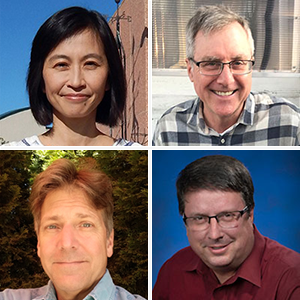Cloud and Precipitation Constituent Group Zeroes In on Measurement Needs
Published: 28 September 2023
Editor’s note: Christine Chiu, chair of the Cloud and Precipitation Measurements and Science Group (CPMSG), and group members Christopher Williams, Michael Jensen, and Rob Newsom provided the following blog post.

To answer key questions in cloud and precipitation science and address associated critical measurement barriers, CPMSG members convened a number of breakout sessions at the Joint ARM User Facility/Atmospheric System Research (ASR) Principal Investigators Meeting, which took place August 7–10, 2023.
The “Update and Discussion on recommended priorities in cloud and precipitation science and measurements” breakout session targeted three measurement needs identified in the 2020 ARM Decadal Vision: cloud droplet number concentration, liquid water path in the presence of precipitation, and vertical air motion.
The community has made great progress in estimating cloud droplet number concentration using remote sensing observations. Thanks to ARM’s Aerosol and Cloud Experiments in the Eastern North Atlantic (ACE-ENA) field campaign, its aircraft in situ cloud probe measurements provided a unique opportunity for evaluating several retrieval algorithms for the first time. Similarly, measuring liquid water path in the presence of precipitation just became possible a few years ago, but challenges remain when precipitation reaches the ground. We remain optimistic since several potential approaches were proposed in the breakout session. The CPMSG will continue working with the community and ARM to seek the solution.
ARM has 10-plus years of clear-air vertical velocity measurements for boundary layers from lidar observations. Estimating in-cloud vertical air motion appears to be much more difficult, but it is not impossible. Existing retrievals may be quite uncertain and require further studies. However, the modeling community has expressed that even if the uncertainty is large, the lack of in-cloud vertical air motion measurements is so severe that any estimate with well-characterized uncertainty will be invaluable for evaluating models and informing possible pathways for improvement.
Exploring the Need for Cloud and Thermodynamic Fields
The ARM Decadal Vision also identified the need for three-dimensional (3D) cloud and thermodynamic fields. Based on the input collected by the CPMSG, the need is no longer limited to 3D, but extended to four-dimensional (4D) fields that include the time component!
One of the roadblocks to understanding convection processes is a poorly observed, localized, 4D environment. This roadblock was discussed in the “Building Collaborations around TRACER Science Objectives” breakout session, focusing on observations of aerosol and thermodynamic spatiotemporal variability, their co-variability, and their impacts on aerosol-convection interactions. This breakout session also initiated a TRACER Model-Intercomparison Project to specifically look into model biases and large model spread in aerosol-cloud interaction assessment.
Information on 4D thermodynamic fields will be enhanced by ARM lidar observations. The “Lidar Applications” breakout session highlighted several ongoing efforts in this aspect, including implementing various Doppler lidar scan strategies and building lidar simulators to enable direct comparisons between the modeled and observed radial velocity fields. The ARM lidar infrastructure team continues to seek feedback, and it plans to expand the number of scan types used at all sites and facilities next year.
Keep up with the Atmospheric Observer
Updates on ARM news, events, and opportunities delivered to your inbox
ARM User Profile
ARM welcomes users from all institutions and nations. A free ARM user account is needed to access ARM data.


















